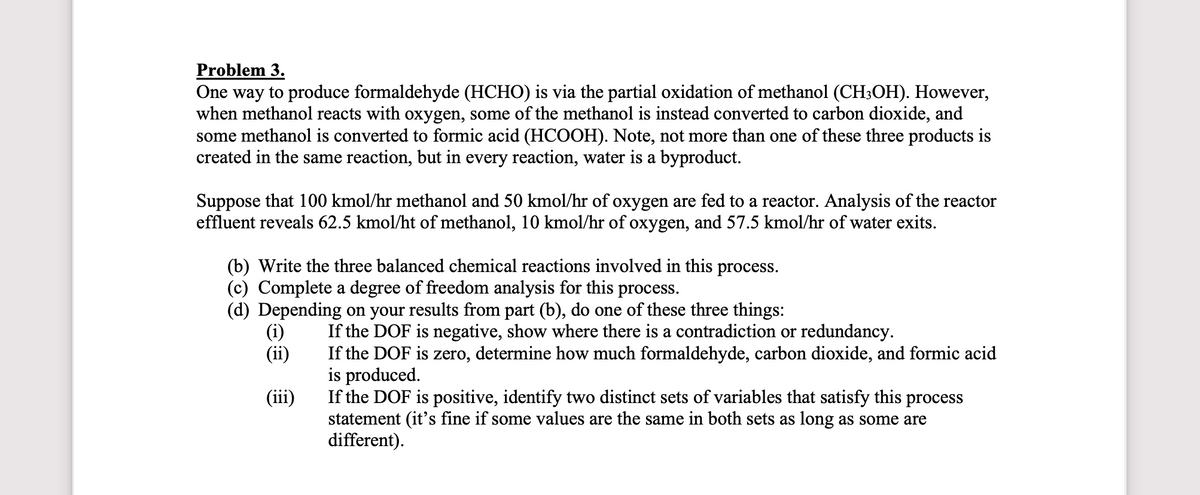Problem 3. One way to produce formaldehyde (HCHO) is via the partial oxidation of methanol (CH3OH). However, when methanol reacts with oxygen, some of the methanol is instead converted to carbon dioxide, and some methanol is converted to formic acid (HCOOH). Note, not more than one of these three products is created in the same reaction, but in every reaction, water is a byproduct. Suppose that 100 kmol/hr methanol and 50 kmol/hr of oxygen are fed to a reactor. Analysis of the reactor effluent reveals 62.5 kmol/ht of methanol, 10 kmol/hr of oxygen, and 57.5 kmol/hr of water exits. (b) Write the three balanced chemical reactions involved in this process. (c) Complete a degree of freedom analysis for this process. (d) Depending on your results from part (b), do one of these three things: (i) (ii) (iii) If the DOF is negative, show where there is a contradiction or redundancy. If the DOF is zero, determine how much formaldehyde, carbon dioxide, and formic acid is produced. If the DOF is positive, identify two distinct sets of variables that satisfy this process statement (it's fine if some values are the same in both sets as long as some are different).
Problem 3. One way to produce formaldehyde (HCHO) is via the partial oxidation of methanol (CH3OH). However, when methanol reacts with oxygen, some of the methanol is instead converted to carbon dioxide, and some methanol is converted to formic acid (HCOOH). Note, not more than one of these three products is created in the same reaction, but in every reaction, water is a byproduct. Suppose that 100 kmol/hr methanol and 50 kmol/hr of oxygen are fed to a reactor. Analysis of the reactor effluent reveals 62.5 kmol/ht of methanol, 10 kmol/hr of oxygen, and 57.5 kmol/hr of water exits. (b) Write the three balanced chemical reactions involved in this process. (c) Complete a degree of freedom analysis for this process. (d) Depending on your results from part (b), do one of these three things: (i) (ii) (iii) If the DOF is negative, show where there is a contradiction or redundancy. If the DOF is zero, determine how much formaldehyde, carbon dioxide, and formic acid is produced. If the DOF is positive, identify two distinct sets of variables that satisfy this process statement (it's fine if some values are the same in both sets as long as some are different).
Introduction to Chemical Engineering Thermodynamics
8th Edition
ISBN:9781259696527
Author:J.M. Smith Termodinamica en ingenieria quimica, Hendrick C Van Ness, Michael Abbott, Mark Swihart
Publisher:J.M. Smith Termodinamica en ingenieria quimica, Hendrick C Van Ness, Michael Abbott, Mark Swihart
Chapter1: Introduction
Section: Chapter Questions
Problem 1.1P
Related questions
Question
100%

Transcribed Image Text:Problem 3.
One way to produce formaldehyde (HCHO) is via the partial oxidation of methanol (CH3OH). However,
when methanol reacts with oxygen, some of the methanol is instead converted to carbon dioxide, and
some methanol is converted to formic acid (HCOOH). Note, not more than one of these three products is
created in the same reaction, but in every reaction, water is a byproduct.
Suppose that 100 kmol/hr methanol and 50 kmol/hr of oxygen are fed to a reactor. Analysis of the reactor
effluent reveals 62.5 kmol/ht of methanol, 10 kmol/hr of oxygen, and 57.5 kmol/hr of water exits.
(b) Write the three balanced chemical reactions involved in this process.
(c) Complete a degree of freedom analysis for this process.
(d) Depending on your results from part (b), do one of these three things:
(i)
(ii)
(iii)
If the DOF is negative, show where there is a contradiction or redundancy.
If the DOF is zero, determine how much formaldehyde, carbon dioxide, and formic acid
is produced.
If the DOF is positive, identify two distinct sets of variables that satisfy this process
statement (it's fine if some values are the same in both sets as long as some are
different).
Expert Solution
This question has been solved!
Explore an expertly crafted, step-by-step solution for a thorough understanding of key concepts.
This is a popular solution!
Trending now
This is a popular solution!
Step by step
Solved in 5 steps

Follow-up Questions
Read through expert solutions to related follow-up questions below.
Follow-up Question
Could you upload this on paper? And show how did you solve for steps 3 and 4.
Solution
Recommended textbooks for you

Introduction to Chemical Engineering Thermodynami…
Chemical Engineering
ISBN:
9781259696527
Author:
J.M. Smith Termodinamica en ingenieria quimica, Hendrick C Van Ness, Michael Abbott, Mark Swihart
Publisher:
McGraw-Hill Education

Elementary Principles of Chemical Processes, Bind…
Chemical Engineering
ISBN:
9781118431221
Author:
Richard M. Felder, Ronald W. Rousseau, Lisa G. Bullard
Publisher:
WILEY

Elements of Chemical Reaction Engineering (5th Ed…
Chemical Engineering
ISBN:
9780133887518
Author:
H. Scott Fogler
Publisher:
Prentice Hall

Introduction to Chemical Engineering Thermodynami…
Chemical Engineering
ISBN:
9781259696527
Author:
J.M. Smith Termodinamica en ingenieria quimica, Hendrick C Van Ness, Michael Abbott, Mark Swihart
Publisher:
McGraw-Hill Education

Elementary Principles of Chemical Processes, Bind…
Chemical Engineering
ISBN:
9781118431221
Author:
Richard M. Felder, Ronald W. Rousseau, Lisa G. Bullard
Publisher:
WILEY

Elements of Chemical Reaction Engineering (5th Ed…
Chemical Engineering
ISBN:
9780133887518
Author:
H. Scott Fogler
Publisher:
Prentice Hall


Industrial Plastics: Theory and Applications
Chemical Engineering
ISBN:
9781285061238
Author:
Lokensgard, Erik
Publisher:
Delmar Cengage Learning

Unit Operations of Chemical Engineering
Chemical Engineering
ISBN:
9780072848236
Author:
Warren McCabe, Julian C. Smith, Peter Harriott
Publisher:
McGraw-Hill Companies, The